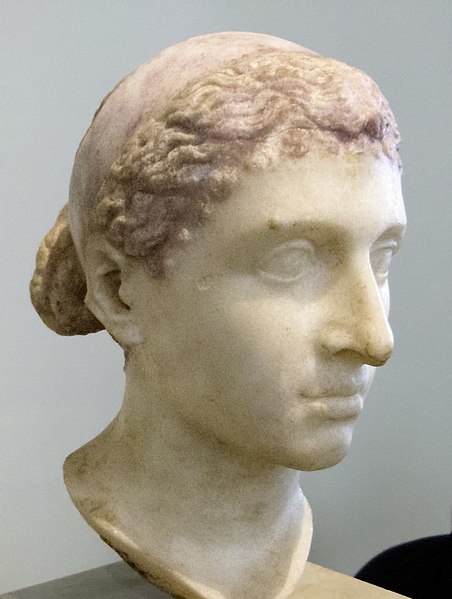 |
| Bust of Cleopatra. Altes Museum, Berlin Source Wikipedia |
To create a ballet set in Ptolemaic Egypt at the time that Rome transitioned from republic to empire covering such momentous events as the assassination of Julius Caesar and the battle of Actium and featuring such important figures from history and literature as Julius Caesar, Mark Antony, Augustus and Cleopatra was quite a challenge. Ashton never tried anything like that. Neither did Macmillan though he did tackle historical events in Anastasia and Mayerling. Nor, indeed, did any of the great choreographers of the imperial or soviet eras. The nearest I can think of is Spartacus which was set in the servile wars. David Nixon and Northern Ballet accepted that challenge and I think that they succeeded. I left the theatre quite dazed. Something that rarely happens to me and never before in ballet. The normal laudatory adjectives - even superlatives - will not do justice to this work so this will be a factual, possibly even clinical, review.
The first thing that impressed me was that an enormous amount of work had been done not just by Nixon but also by the other members of the creative team and indeed Martha Leebolt who danced Cleopatra and for whom the role was created. In the programme she wrote that she had prepared for the ballet by reading lots of books, watching the film and everything on TV that she could find. She took in anything and everything because she was aware that even the smallest detail strengthens a character and makes it more realistic. This is a fascinating period of classical history that has interested me since the age of 7 and I know it well. I actually studied it formally for my A levels in Latin and Roman history and informally before and since. I have visited the temples and seen the artefacts of Hellenistic Egypt in the great museums around the world. Even though a ballet does not have to be a historical document it is clear that considerable trouble was taken to get the history and the artistic details right.
For those who have yet to see the ballet the story and the characters are set out on the company's website. The score, specially composed by Claude-Michel Schönberg, can be downloaded from Amazon or i-tunes or heard by Spotify subscribers through the music page. The stage designs were spectacular and ingenious transporting the audience seamlessly from Wadjet's temple to Ptolemy's palace, a vessel in full sail, the streets and senate of Rome and back to Egypt. Equally impressive were the costumes from Cleopatra's regalia to the deities of ancient Egypt who appeared in the last scene as Cleopatra's spirit entered the afterlife.
The choreography covered two murders, riots and commotion, a great battle, love scenes of Cleopatra with Ptolemy, Julius Caesar and Mark Antony, Cleopatra's confrontation with Octavia and her worship of Wadjet and much more. I cannot begin to describe it all. There is only so much that the senses can absorb but there are sequences that stick particularly in my memory such as the opening and closing scenes of Cleopatra and Wadjet and the battle of wills between Cleopatra and Octavia.
A stellar cast danced last night. On stage with Martha Leebolt were her handmaidens Charmian and Iris danced by Pippa Moore and Antoinette Brooks-Daw, three of the company's best. The other strong female role was Octavia performed by Hannah Bateman yet another star. For me, Octavia's encounter with Cleopatra in which both dancers showed their considerable acting skills was the high point of the evening. As for the men, there were impressive performances by Kenneth Tindall as Wadget, Javier Torres as Caesar and Tobias Batley as Mark Antony. Everyone danced well from principals downwards.
This is a ballet that has to be seen more than once and probably many times to be appreciated fully. It is to be performed only in two theatres, The Grand in Leeds until 15 March and then The Lyceum in Sheffield between the 25 and 29 March 2014. We have had to wait since 2011 for the return of this work. Goodness knows how long we shall have to wait to see it again.
Post Script
7 March 2914 Reinforcing my impression that David Nixon had done an extraordinary amount of background research, Dolly Williams has displayed some of the costume designs in Cleopatra Fashion Fix. She mentions that David Nixon contributed to these drawings in collaboration with Christopher Giles. I particularly like the headgear of Apis who was one of the gods who greeted Cleopatra's spirit in the last scene together with Anubis and one other whose identity I struggle to remember.
Further Reading
21 March 2014 Lauren Godfrey "Why I love Cleopatra"
7 March 2014 "Hail the queen of ballets" Derbyshire Times
6 March 2014 "Video: Cleopatra back in region after £1m success of national tour" Yorkshire Post

No comments:
Post a Comment